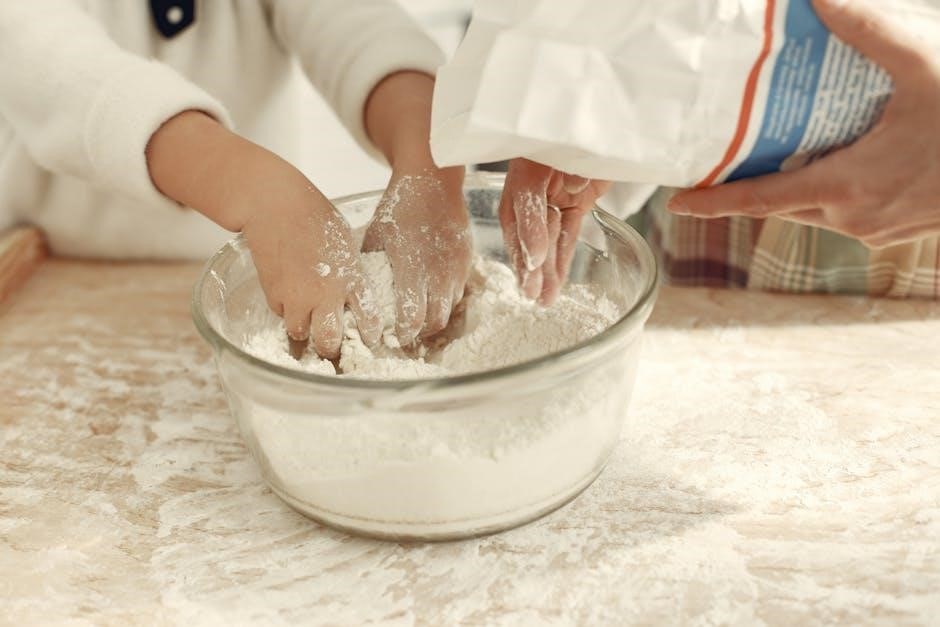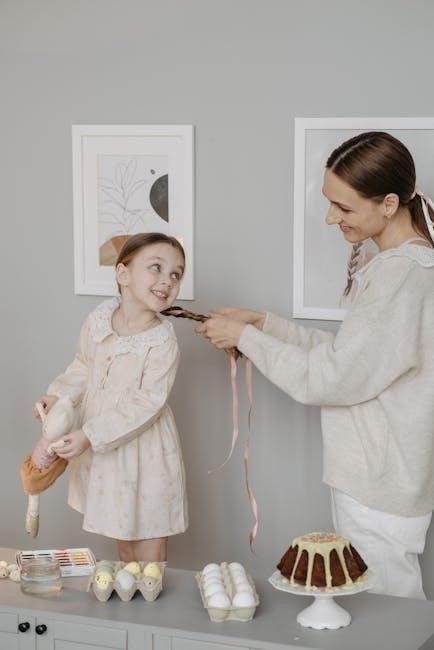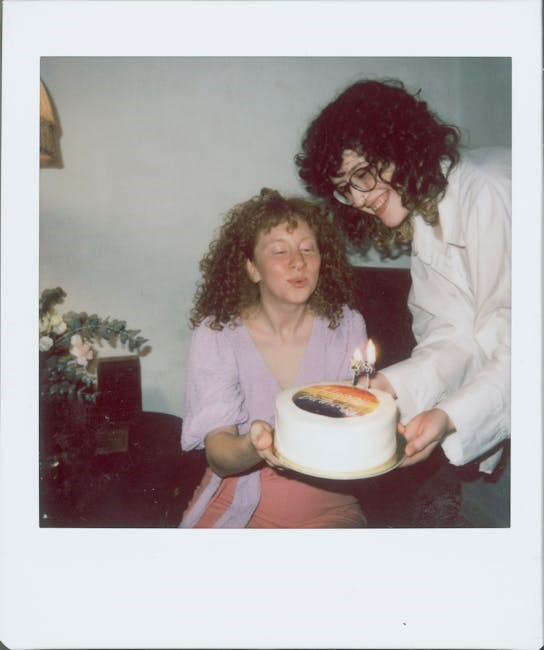Free printable cake care instructions ensure your creations stay fresh and beautiful․ These guides provide easy-to-follow tips for transporting, storing, and serving cakes, making them a must-have for bakers․
Importance of Cake Care
Proper cake care is crucial for maintaining freshness, structure, and safety․ Free printable guides offer clear instructions, ensuring cakes remain intact and delicious․ Whether for tiered masterpieces or delicate fondant designs, these resources prevent damage and extend shelf life․ Clear care instructions also enhance customer satisfaction, guiding them on handling, storage, and serving․ This ensures your hard work as a baker is preserved and enjoyed as intended․ Printable cake care instructions are especially vital for special occasions like weddings, where mishandling could ruin the event․ By providing these guides, you empower clients to care for their cakes confidently, protecting your reputation and their experience․ Essential for every baker, these instructions are a simple yet impactful way to ensure success․
Benefits of Printable Cake Care Guides
Printable cake care guides offer numerous benefits for bakers and clients alike․ They provide clear, concise instructions on transporting, storing, and serving cakes, ensuring optimal freshness and presentation․ These guides are easily customizable, allowing bakers to tailor information to specific cake types, such as fondant or buttercream․ Clients appreciate the convenience of having step-by-step care instructions, reducing anxiety and potential mistakes․ Printable formats also enable professional branding, enhancing customer perception; Additionally, digital templates can be quickly edited and shared, saving time and resources․ By empowering clients with knowledge, these guides foster trust and satisfaction, making them an invaluable tool for bakeries and home bakers․ They truly enhance the overall cake care experience․

Transporting Cakes Safely
Use non-slip mats and sturdy cake boxes to prevent movement․ Drive smoothly, avoiding sharp turns․ Ensure cakes are securely placed to maintain stability during transport․ Learn more here․
How to Transport a Tiered Cake
Transporting a tiered cake requires extra care to ensure stability and prevent damage․ Use a sturdy cake box or carrier with non-slip mats to secure the cake․ Place each tier separately if possible, or stack them using dowels for support․ Keep the cake chilled before transport to firm the frosting, reducing movement․ Drive smoothly, avoiding sudden turns or brakes․ Consider having an assistant to hold the cake steady during transit․ Follow these steps to deliver your tiered cake safely and intact․ Proper transportation ensures your masterpiece arrives as stunning as it left the bakery․ A well-planned transport strategy is key to preserving the cake’s beauty and structure․
Using Non-Slip Mats and Cake Boxes
Non-slip mats and cake boxes are essential for safe cake transportation․ Place a non-slip mat on the base of the cake box to prevent movement during transit․ Choose a box that fits the cake snugly, ensuring no part touches the sides․ For tiered cakes, use a box with adjustable compartments or separate boxes for each tier․ Secure the cake with dowels or skewers if needed․ These tools minimize vibrations and shocks, protecting the cake’s structure․ Always keep the cake upright and avoid stacking objects on top․ Using the right materials ensures your cake arrives intact and flawless, maintaining its appearance and quality for your clients․ Proper packaging is vital for professional cake delivery․
Tips for Long-Distance Cake Transportation
For long-distance cake transportation, use sturdy cake boxes with secure lids to prevent damage․ Place non-slip mats inside to minimize movement․ Keep the cake upright to avoid tilting and ensure even support․ For tiered cakes, transport each tier separately or secure them tightly with dowels․ Maintain a consistent, cool temperature to prevent melting or softening․ Avoid sudden stops or sharp turns during travel․ Consider using insulated boxes for temperature-sensitive cakes․ Always test the box’s stability before transporting․ Provide clients with care instructions to handle the cake upon arrival․ Proper packaging and careful handling ensure the cake arrives fresh and intact, even over long distances․ Plan the route and timing to minimize travel duration and stress on the cake․

Storing Cakes Properly
Store cakes in airtight containers at room temperature or refrigerate to maintain freshness․ Freeze for longer preservation, ensuring proper wrapping to prevent moisture loss and contamination․
Room Temperature Storage Guidelines
Store cakes at room temperature in an airtight container to maintain freshness․ Keep them away from direct sunlight and strong-smelling foods to prevent absorption of odors․ Ensure the storage area is cool, dry, and stable, with consistent temperature and humidity levels․ Most cakes can be kept at room temperature for 2-3 days, depending on ingredients․ Avoid placing cakes near heating vents or ovens․ For optimal freshness, use a cake keeper or wrap tightly in plastic wrap or aluminum foil․ This method is ideal for short-term storage and keeps cakes moist and ready to serve․ Always check for any signs of spoilage before consumption․
Refrigeration Best Practices
Refrigeration is essential for extending the shelf life of cakes, especially those with perishable ingredients like buttercream or fondant․ Always cool the cake to room temperature before refrigerating to prevent condensation․ Wrap the cake tightly in plastic wrap or aluminum foil and place it in an airtight container to maintain freshness․ Refrigerate at a consistent temperature below 40°F (4°C)․ Avoid refrigerating cakes with whipped cream or mousse, as they may not hold up well․ For tiered or custom cakes, refrigerate each layer separately if possible․ Before serving, allow the cake to come to room temperature for optimal flavor and texture․ Most cakes can be stored in the fridge for 3-7 days, depending on ingredients․
How to Freeze a Cake for Later Use
Freezing is an excellent way to preserve cakes for future events․ Cool the cake completely to room temperature before freezing to prevent moisture buildup․ Wrap the cake tightly in plastic wrap or aluminum foil, then place it in an airtight container or freezer-safe bag to avoid freezer burn․ Label and date the container for easy identification․ Store in the freezer at 0°F (-18°C) for up to 3-6 months․ For tiered cakes, freeze each layer separately․ To thaw, place the cake in the refrigerator overnight or at room temperature for a few hours, depending on size․ Avoid direct sunlight during thawing․ Most cakes retain their quality when frozen properly, but avoid freezing cakes with whipped cream or unstable decorations․

Serving and Cutting Cakes
Proper serving and cutting techniques ensure your cake remains intact and visually appealing․ Use sharp tools, handle gently, and follow step-by-step guides for flawless presentation and portioning․
How to Cut a Tall Tier Cake
Cutting a tall tier cake requires precision and care to ensure even portions and a clean presentation․ Start by stabilizing the cake with dowels or supports․ Use a long serrated knife and make gentle sawing motions․ For multi-tier cakes, remove each tier separately before slicing․ Place the cake on a sturdy stand or turntable for better access․ Apply even pressure and avoid applying too much force, which can cause tiers to shift․ After each cut, clean the knife to prevent crumbs from transferring between slices․ Consider using a cake leveler for uniformity․ Always cut on a stable surface and ensure the cake is completely set before serving․ This method ensures a professional finish and delighted guests․
Techniques for Cutting a Double Barrel Cake
Cutting a double barrel cake, which consists of two stacked layers, requires careful planning to ensure even portions and a clean presentation․ Start by placing the cake on a sturdy stand or turntable․ Use a long serrated knife to make horizontal cuts across both layers simultaneously, starting from the top and working downward․ For smaller portions, cut vertically between the barrels before slicing․ Always apply gentle, even pressure to avoid compressing the layers․ Consider using a cake leveler for uniformity․ After each cut, clean the knife to prevent crumbs from transferring․ This method ensures a professional finish and delighted guests․ Proper cutting techniques preserve the cake’s structural integrity and appearance․
Professional Cake Serving Tips
Professional cake serving involves presentation, portion control, and maintaining freshness․ Use a cake stand to elevate the dessert, ensuring visibility and accessibility․ Allow the cake to reach room temperature before serving for optimal flavor․ Cut slices evenly using a serrated knife, wiping the blade between cuts to prevent crumbs from spreading․ Serve with accompaniments like fresh fruit or whipped cream for added appeal․ For tiered cakes, start serving from the bottom layer to preserve the structural integrity․ Keep serving utensils clean and organized․ Provide clear instructions for guests on how to handle and plate their slices․ These tips ensure a polished and enjoyable experience for everyone․ Proper serving techniques enhance both the cake’s appearance and taste, making every event memorable․ Always prioritize hygiene and efficiency when serving cakes professionally․

Cake Care for Specific Types
Free printable cake care instructions offer tailored advice for specific cake types, ensuring they remain fresh and visually appealing․ These guides cover handling, storage, and serving tips for fondant, tiered, and buttercream cakes, helping bakers maintain their creations’ integrity and presentation․
How to Store a Fondant Cake
Storing a fondant cake requires careful attention to maintain its appearance and freshness․ Fondant cakes should not be refrigerated, as moisture can cause the fondant to become sticky or discolored․ Instead, store them in a cool, dry place at room temperature, away from direct sunlight or heat sources․ Use an airtight container or wrap the cake securely in plastic wrap to prevent dust and moisture exposure․ If the cake is large or tiered, place it on a sturdy cardboard base or cake keeper for support․ For long-term storage, fondant cakes can be frozen, but ensure they are wrapped tightly in plastic wrap and placed in a freezer-safe bag․ Allow the cake to thaw at room temperature when ready to serve․ Proper storage ensures the fondant remains smooth and intact, preserving the cake’s beauty and flavor․
Caring for Custom and Wedding Cakes
Caring for custom and wedding cakes requires precise attention to detail to preserve their intricate designs and freshness․ Store them in a cool, dry environment at room temperature, avoiding direct sunlight and moisture․ For wedding cakes, especially tiered ones, use a sturdy base or cake stand to prevent structural damage․ Cover the cake with a breathable cloth or plastic wrap to protect it from dust․ Avoid refrigeration unless necessary, as it can cause decorations to soften or melt․ If refrigerating, ensure the cake is tightly wrapped․ Freeze only if the cake won’t be served for an extended period, using airtight packaging․ Always transport tiered cakes assembled to maintain stability․ Provide clear instructions to clients to ensure proper handling and storage, keeping the cake fresh and visually stunning for the special day․
Special Instructions for Buttercream Cakes
Buttercream cakes require specific care to maintain their texture and appearance․ Store them at room temperature in a cool, dry place, avoiding direct sunlight and moisture․ Avoid refrigeration, as it can cause the buttercream to harden or separate․ If refrigeration is necessary, let the cake return to room temperature before serving․ When transporting, use a non-slip mat or cake box to prevent movement․ For tiered buttercream cakes, ensure each tier is securely stacked․ Provide clients with clear instructions to handle the cake gently and avoid extreme temperatures․ This ensures the buttercream remains smooth and the cake stays fresh for serving․ Always include these tips in your printable cake care guides for optimal results․

Creating Printable Cake Care Instructions
Design elegant, customizable cake care cards using editable templates․ Include tips for handling, storing, and serving․ Ensure clarity and style for professional distribution to clients and customers․
Design Tips for Cake Care Cards
When designing cake care cards, prioritize clarity and aesthetics․ Use clean, readable fonts and high-quality images․ Include essential sections like handling, storage, and serving tips․ Ensure the layout is user-friendly, with clear headings and bullet points for easy scanning․ Incorporate your brand’s colors and logo for a professional look․ Add visual cues like icons or illustrations to make the instructions engaging․ Use editable templates to customize the content according to your needs․ Ensure the design is print-friendly, with proper margins and spacing․ Double-check for spelling and formatting errors before printing․ Make sure the card is durable and easy to clean․ Consider offering digital versions for eco-friendly options․ These tips ensure your cake care cards are both functional and visually appealing, enhancing your professional image and customer satisfaction․
How to Edit and Customize Templates

Editing and customizing cake care templates is straightforward․ Use platforms like Canva or Corjl to modify text, colors, and images․ Start by downloading an editable template, then open it in your preferred design tool․ Replace placeholder text with your specific instructions, such as storage tips or serving guidelines․ Adjust fonts, colors, and layouts to match your brand․ Add your logo or business name for a professional touch․ Include visuals like icons or images to enhance readability․ Ensure all information is concise and clear․ Save your design as a printable PDF or JPEG․ Finally, proofread for errors and print on high-quality paper or cardstock for a polished finish․
Tools for Creating Editable PDFs
Various tools simplify the creation of editable PDFs for cake care instructions․ Canva and Corjl are popular choices, offering user-friendly interfaces to design and edit templates․ Adobe Acrobat allows advanced editing and form creation, while Smallpdf provides quick conversion and editing options․ Online platforms like Templafy enable template customization directly in your browser․ Many free templates are available as downloadable PDFs, which can be edited using these tools․ Ensure compatibility with mobile devices for accessibility․ These tools help create professional, clear, and customizable PDFs, making it easy to provide clients with detailed cake care guidance․ Use them to enhance your instructions with visuals and ensure clarity for optimal results․

Free Resources and Templates
Find free printable cake care instructions online, offering customizable templates for clear guidance on transporting, storing, and serving cakes․ Downloadable PDFs ensure professional and easy-to-follow instructions always․
Where to Find Free Cake Care Templates
Discover a variety of free printable cake care templates on platforms like Etsy, Canva, and Pinterest․ These templates are designed to be customizable, allowing you to add your branding or specific instructions․ Many websites offer downloadable PDFs that can be easily edited and printed․ Popular marketplaces provide instant downloads, perfect for bakers and cake designers․ Additionally, blogs and baking communities often share free cake care guides tailored for different types of cakes, such as wedding or fondant cakes․ These resources ensure you can provide professional care instructions to clients, helping them maintain the freshness and presentation of their cakes․
Downloadable Cake Care Guides
Downloadable cake care guides offer a convenient way to share detailed instructions with clients․ These guides are often available as editable PDFs or Canva templates, allowing for customization․ Many platforms, such as Etsy and Pinterest, provide instant downloads that can be tailored to specific cake types, like wedding or fondant cakes․ These guides typically include tips on transportation, storage, and serving, ensuring cakes remain fresh and visually appealing․ By offering downloadable care guides, bakers can enhance client satisfaction and maintain the quality of their creations․ These resources are user-friendly and designed to be easily printed or shared digitally, making them a practical tool for cake enthusiasts and professionals alike․
Editable Cake Care Card Examples
Editable cake care card examples provide bakers with customizable templates to share detailed instructions with clients․ These cards are often designed as printable PDFs or Canva templates, allowing for personalization with business branding and specific cake details․ Many examples include sections for care tips, transportation advice, and serving instructions, ensuring clients can easily follow guidelines․ Platforms like Etsy and Corjl offer instant downloads of these templates, which can be tailored to suit various cake types, such as wedding or fondant cakes․ By using these examples, bakers can create professional-looking care cards that enhance client communication and maintain the quality of their baked goods․ These editable designs are both practical and visually appealing, making them a popular choice for cake enthusiasts and professionals alike․

Common Mistakes to Avoid
Common mistakes include not using non-slip mats, overloading cake boxes, and failing to communicate care instructions clearly․ These errors can damage cakes and disappoint clients, emphasizing the need for proper handling and clear guidance in cake care instructions․
Mistakes in Cake Transportation
One of the most common mistakes in cake transportation is failing to use non-slip mats or sturdy cake boxes, which can lead to shifting or damage․ Overloading the vehicle with too many cakes at once increases the risk of accidents․ Another error is not securing the cake properly, especially for tiered or fragile designs․ Poor communication of transportation instructions to clients can result in mishandling․ Additionally, not accounting for weather conditions, such as heat or humidity, can affect the cake’s stability․ Using flimsy packaging or inadequate support systems also poses risks․ These mistakes can ruin the cake’s appearance and structure, emphasizing the importance of following proper transportation guidelines․
Storage Mistakes That Can Ruin a Cake

Improper storage is a common issue that can damage cakes․ Storing cakes near direct sunlight or heat sources can cause melting or drying out․ Humidity and temperature fluctuations also affect texture and freshness․ Using improper containers, such as those that allow air to circulate, can lead to staleness․ Forgetting to refrigerate perishable cakes, like those with buttercream or cream fillings, can result in spoilage․ Additionally, overcrowding in the refrigerator can cause cakes to stick together or get damaged․ Freezing without proper wrapping leads to freezer burn, while thawing at room temperature can cause sogginess․ These mistakes highlight the importance of adhering to specific storage guidelines to maintain quality and appearance․
Common Errors in Cake Serving
Common errors in cake serving often stem from improper handling and presentation․ Using the wrong knife or cutting uneven slices can lead to messy portions and wasted cake․ Neglecting to let the cake come to room temperature before serving can result in a dense texture and reduced flavor․ Overhandling tall or tiered cakes can cause structural collapse, while improper use of serving utensils may damage the cake’s appearance․ Additionally, not using a serving spatula to transfer slices can lead to breaking or smudging․ These mistakes can be avoided by following simple serving guidelines, ensuring a professional and visually appealing presentation every time․
Free printable cake care instructions ensure your creations remain fresh and visually appealing․ Proper handling, storage, and serving techniques maintain quality, while customizable guides offer tailored solutions for every baker․
Proper cake care ensures longevity and freshness, starting with safe transportation using non-slip mats and sturdy boxes․ Store cakes at room temperature away from direct sunlight for up to 3 days, or refrigerate for up to 5 days․ For longer preservation, freezing is ideal, with cakes thawing at room temperature․ When serving, use sharp knives and even pressure for clean cuts․ Provide clear instructions to clients, including handling, storage, and serving tips․ These practices maintain cake quality, ensuring every slice remains delicious and visually appealing․ Printable guides offer customizable solutions, making it easy to share expert advice with customers․
The Value of Providing Clear Instructions
Providing clear cake care instructions enhances customer satisfaction and protects your creations․ Printable guides ensure clients understand how to transport, store, and serve cakes properly, reducing errors․ They also build trust, showing professionalism and care․ Including details like handling tips and storage timelines helps maintain cake quality․ These guides are customizable, allowing you to brand them and add specific advice․ Offering such resources demonstrates your commitment to excellence, fostering positive reviews and repeat business․ Clear instructions empower customers, ensuring your cakes remain fresh and presentable, reflecting well on your craftsmanship and attention to detail․ It’s a simple yet effective way to elevate your service and customer experience․
